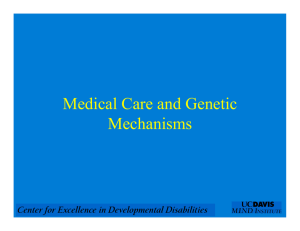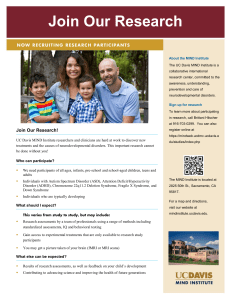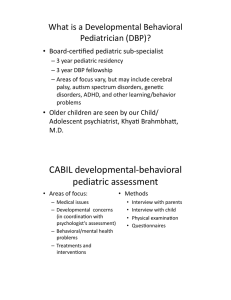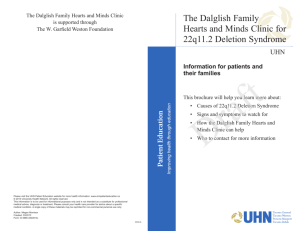Document 13236492
advertisement
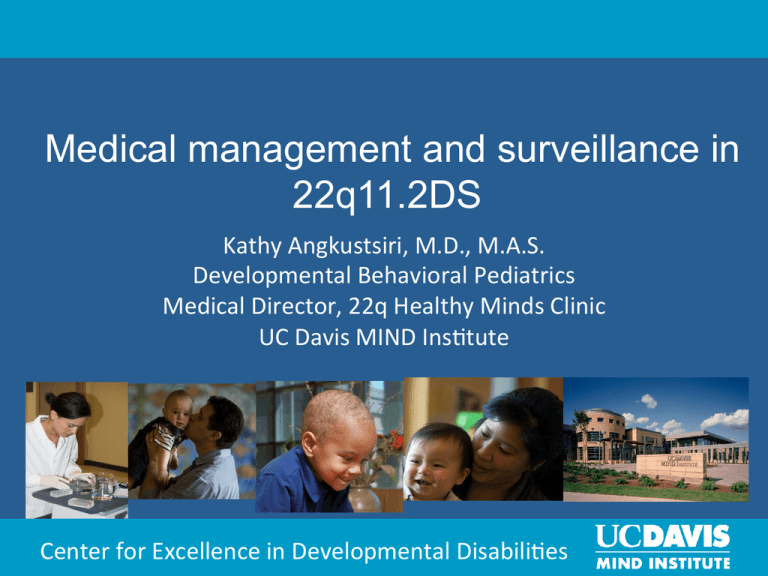
Medical management and surveillance in 22q11.2DS Kathy Angkustsiri, M.D., M.A.S. Developmental Behavioral Pediatrics Medical Director, 22q Healthy Minds Clinic UC Davis MIND InsEtute Center for Excellence in Developmental DisabiliEes Outline • What is chromosome 22q11.2 deleEon syndrome (22q11.2DS)? • Clinical features – Medical issues and surveillance – Behavioral and educaEonal concerns • Summary and recommendaEons All the names…. • • • • • • Velo-­‐cardio-­‐facial syndrome (VCSF) Conotruncal anomaly face syndrome (CAFS) DiGeorge syndrome (DGS) Autosomal dominant Opitz G/BBB syndrome Cayler Cardiofacial syndrome 22q11.2DS 22q11.2 deleEon 22q11.2 deleEon • EsEmated incidence 1:2000-­‐4000 live births • Most are “de novo” (new) deleEon – Affected individuals have a 50% chance of passing the deleEon to offspring (autosomal dominant) • Large spectrum of involvement – Heart – Face/Palate – Immune – Developmental – Others hap://pharyngula.org/index/weblog/comments/ deep_homologies_in_the_pharyngeal_arches/ hap://www.ucdmc.ucdavis.edu/mindinsEtute/research/cabil/cabil_video.html Heart / Cardiac Problems (75%) • • • • Tetralogy of Fallot Ventricular Septal Defect Pulmonary Stenosis Vessel anomalies – Interrupted aorEc arch – Vascular ring – Aberrant caroEd vessels • Echocardiogram, EKG hap://en.wikipedia.org/wiki/Image:Gray506.svg#file Ear, Nose, Throat hap://homepage.mac.com/changcy/endo.htm • Cleh Palate or Velopharyngeal Incompetence (VPI) (75%) – Feeding difficulEes – Nasal regurgitaEon – Cleh Palate (full, submucous) – Hypernasal Speech, ArEculaEon disorders • Chronic ear infecEons, may need PE tubes – SNHL (10%), CHL (45%) • Vocal cord paralysis • Laryngeal web • Nasendoscopy • RouEne hearing screens • Neck MRI if surgical procedures Bifid uvula www.minor9th.com Immunologic Problems (25-­‐30%) • Low T cells (usually mild with normal funcEon) due to thymus involvement • AnEbody producEon usually intact • Usually improves with age • Recurrent infecEons: ear infecEons, sinusiEs, bronchiEs, pneumonia hap://www.myasthenia.org.au/html/treatments.htm • Flow cytometry (T and B cell counts), anEbody levels, other immune funcEon tests • Important to know immune status before giving live vaccines or blood transfusions • May want to check for adequate vaccine response Endocrine • Hypoparathyroidism (25%) • Low calcium levels (hypocalcemia) – Seizures • Hypothyroid • Short stature • Ionized calcium levels, thyroid levels • Endocrinology referral if abnormal labs or <3rd percenEle on growth curves GastrointesEnal • • • • • Feeding/Failure to Thrive ConsEpaEon GERD (gastroesophageal reflux disease) Hernia MalrotaEon Musculoskeletal • • • • • • Cervical spine anomalies Flat feet Chronic leg pain (hypotonia and flat feet) Hypotonia Polydactyly Craniosynostosis • 5 view c-­‐spine x-­‐rays aher age 4 Eye • • • • Strabismus (lazy eye) Ptosis ReEnal vessels Hooded eyelids • Yearly eye exams, including dilaEon Other Systems • Autoimmune disorders (10%) – – – – – – Blood: platelets (ITP, vWD, Bernard-­‐Soulier), white blood cells Juvenile Rheumatoid ArthriEs (JRA) IgA deficiency Raynaud’s phenomenon Celiac disease ? cancer • Kidney abnormaliEes (33%) – Small kidneys – Duplicated kidneys or renal system • Renal ultrasound Developmental-­‐Behavioral Concerns • Developmental Delays – Motor delays – Speech and language delays – Learning disabiliEes • FSIQ low-­‐average to borderline range • SomeEmes misleading b/c usually verbal IQ beaer than performance IQ • DifficulEes with planning, math, and visuospaEal tasks – Social immaturity Developmental-­‐Behavioral Concerns • AaenEon Deficit/HyperacEvity Disorder (ADHD) 30-­‐50% – Impulsivity – InaaenEve, easily distracted • Anxiety Disorders: 40-­‐60% – Specific phobias – Obsessive Compulsive Disorder – General Anxiety – SeparaEon Anxiety Disorder • Mood disorders Treatments/RecommendaEons • Varies based on individual needs • Behavioral • EducaEonal • Medical – Labs/procedures • Thyroid, calcium, complete blood count, etc. – MedicaEons ADHD treatment • • • • Behavioral intervenEon Classroom modificaEons Parent training MedicaEons – SEmulants – Alpha agonists (use with cauEon if cardiac hx) – AtomoxeEne (Straaera) – Others SEmulants for ADHD • Why the concern? – Cardiac side-­‐effects – Growth – PsychoEc symptoms? – Altered dopamine levels in 22q11.2DS due to COMT? SEmulants in 22q11.2DS • Gothelf 2004 (4 weeks) – 12 children with ADHD – Low dose methylphenidate (0.3 mg/kg) • Gothelf 2011 (6 months) – 0.5 mg/kg – 22 children treated – No psychoEc/manic symptoms – Mild elevaEons in blood pressure • Conclusion: – methylphenidate is effecEve and usually well-­‐tolerated – be aware of side effects and potenEal risks – must weigh risks/benefits with your provider Anxiety treatment • CogniEve behavioral therapy • Social skills group • MedicaEons – SSRI • Side effects – Sleep, headaches, appeEte – Suicidal thinking Resources • Early intervenEon – Speech therapy – OccupaEonal therapy – Physical therapy – Social skills • School – IEP classificaEons • Other Health Impaired (OHI) • Specific Learning Disability (SLD) • Speech/Language impairment (SLI) – 504 plan • Computer assisted learning • Classroom accommodaEons RecommendaEons • At diagnosis or at least once – – – – – – Echocardiogram Immune funcEon ENT-­‐nasendoscopy Cervical spine films Renal ultrasound GeneEc counseling • Yearly – – – – Eye exam Hearing exam CBC, calcium, thyroid Dental • As needed – Craniofacial/cleh palate team – Chest MRI to assess vasculature if surgical procedure in neck area – Endocrinology – Immunology – Hematology – Rheumatology – Orthopedics – Gastroenterology – Neurology – Developmental pediatrician or child psychiatry – School involvement Websites • MIND InsEtute CogniEve Analysis and Brain Imaging Laboratory (CABIL) hap://cabil.mindinsEtute.org • InternaEonal 22q11.2 FoundaEon hap://www.22q.org/ • VCSF EducaEonal FoundaEon, Inc. hap://www.vcfsef.org/ • CHOP The 22q and You Center hap://www.chop.edu/consumer/jsp/division/generic.jsp? id=74654 • Chromosome 22 Central www.c22c.org • Books: • EducaEng Children with Velo-­‐Cardio-­‐Facial Syndrome by Donna Cutler-­‐Landsman • Missing GeneEc Pieces. Strategies for Living With VCSF by Sherry Baker-­‐Gomez References • Bassea, AS, et al. "PracEcal guidelines for managing paEents with 22q11. 2 deleEon syndrome." J Pediatrics 2011; 159.2:332. • Kobrynski LJ and Sullivan KE. Velocardiofacial syndrome, DiGeorge syndrome: the chromosome 22q11.2 deleEon syndromes. Lancet 2007; 370:1443-­‐52. • McDonald-­‐McGinn, Emmanuael BS, Zackai EH. 22q11.2 DeleEon Syndrome. GeneReviews; 2005. www.genetests.org • Shprintzen RJ. 2004 .Velocardiofacial syndrome. In Cassidy SB and Allanson JE, Management of GeneEc Syndromes, p 615-­‐631. New York: Wiley-­‐Liss, Inc. • Tarquinio, DC, et al. "Growth charts for 22q11 deleEon syndrome.“AJMG part A 2012; 158.11: 2672-­‐2681. Thank you! – To all of the families who have parEcipated in research – CogniEve Analysis and Brain Imaging Laboratory (CABIL) Funded by: • NaEonal InsEtutes of Health – 2R01HD42974, 1R01HD46159, 1RL1NS62412 (Simon) • Center for Excellence in Developmental DisabiliEes (CEDD) – AdministraEon on Developmental DisabiliEes 90DD0596 (Hansen) • UC Davis – M.I.N.D. InsEtute – Clinical and TranslaEonal Science Center UL1 RR024146
